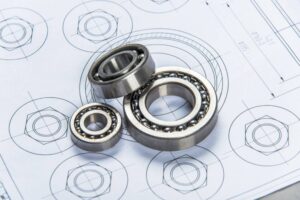
Selecting the correct ball bearing is essential to ensure proper machine operation and long service life. The right choice not only prevents mechanical failures but also reduces the need for frequent maintenance, saving time and resources. When selecting a bearing, it’s crucial to consider the specific application and the requirements of your equipment. Each machine has its own operating conditions, such as load, speed, and working environment. Understanding these demands helps identify the bearing best suited to support the conditions, maximizing efficiency and performance.
Understand the Application and Work Environment
To select the proper bearing, you must clearly understand its application within the system. This means identifying the exact function the bearing will serve—whether supporting axial or radial loads, providing rigidity, or reducing friction to allow smooth movement between parts. Knowing the specific role of the bearing not only simplifies selection but also ensures reliable, long-term performance.
Environmental conditions are equally critical. The work environment may dictate the most appropriate material and design to withstand temperature, humidity, or dust. For example:
-
High temperatures → choose materials resistant to heat.
-
Humid or corrosive environments → opt for corrosion-resistant bearings.
-
Dusty or abrasive conditions → sealed bearings help block contaminants.
By considering these factors, you’ll select bearings that both maximize equipment performance and extend service life while minimizing unexpected failures.
Bearing Types and Characteristics
Ball Bearings
Ball bearings are widely used thanks to their ability to operate at high speeds. Their design, with balls between inner and outer raceways, reduces friction and allows smooth motion. They can handle moderate radial and axial loads, making them suitable for electric motors and fans. However, they wear more quickly under heavy-load conditions.
Roller Bearings
Roller bearings are ideal for heavy-load applications. Instead of balls, they use cylindrical rollers, which create a larger contact area and withstand significantly higher radial loads. They are commonly used in heavy machinery, presses, and gear systems. Their robust construction offers excellent durability under demanding conditions.
Self-Aligning Bearings
These bearings are designed for situations where misalignment occurs. They contain two rows of balls with a common spherical raceway, allowing for angular deviation without compromising performance. This makes them essential for conveyor systems or equipment exposed to frequent thermal variations.
Loads and Operating Speeds
When selecting a bearing, it’s vital to define the radial and axial loads:
-
Radial loads act perpendicular to the shaft.
-
Axial loads act along the shaft axis.
For heavy-duty machines or high-power operations, bearings must handle significant stresses. Considering dynamic and static load ratings ensures reliability under continuous or sudden impact conditions.
Operating Speed
The operating speed refers to the maximum continuous speed a bearing can handle without losing efficiency or suffering excessive wear. Factors such as lubrication type and material composition affect this capability.
-
Grease → better sealing against contaminants.
-
Oil → ideal for reducing resistance and dissipating heat.
Exceeding the rated speed or ignoring temperature effects can shorten bearing life. Therefore, selecting a bearing rated for your load and speed profile is essential to ensure durability and consistent performance.
Material and Lubrication
Material selection directly affects bearing durability:
-
Stainless steel → highly resistant to corrosion and chemicals.
-
High-quality alloys → withstand daily wear and heavy-duty applications.
Lubrication is equally critical:
-
Grease lubrication → preferred when sealing against dust and contaminants.
-
Oil lubrication → recommended when lower resistance and better heat dissipation are required.
Proper lubrication reduces noise, improves efficiency, and prevents premature failures. Choosing the right type ensures smoother and longer-lasting machine operation.
Cost and Ease of Maintenance
Price alone should not drive the decision. While low-cost models may seem attractive, high-quality bearings often provide superior durability and lower total ownership cost. Premium bearings are designed to withstand tough conditions, reducing maintenance needs and minimizing risk of breakdowns.
Ease of installation and maintenance is another factor. Bearings that are simple to mount and service save valuable time and resources. Conversely, complex installations or frequent servicing can offset initial savings.
Efficiency and Performance Evaluation
Selecting the right bearing ensures more than cost savings—it safeguards equipment efficiency. Some applications require high-speed capacity, others heavy-load durability, or resistance to harsh conditions. Matching bearing properties to operating demands ensures optimized performance.
Conclusion
When selecting a bearing, consider:
-
Work environment (temperature, humidity, chemicals, contaminants).
-
Load type and size (radial, axial, or combined).
-
Operating speed and lubrication needs.
-
Material quality for durability.
-
Precision requirements for high-performance equipment.
-
Cost-benefit and ease of maintenance over the long term.
Always review the manufacturer’s specifications and, when possible, consult experts. Choosing correctly helps prevent mechanical failures, reduces maintenance frequency, and extends equipment life.
The right bearing selection maximizes performance, ensures reliability, and protects your investment in machinery.






